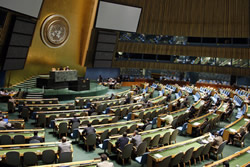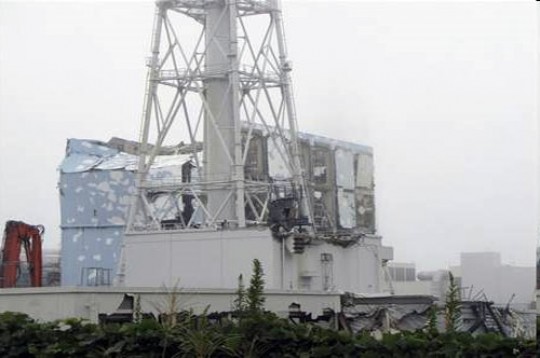UN experts begin assessment of effects of Fukushima nuclear accident
UN experts begin assessment of effects of Fukushima nuclear accident
Destroyed Fukushima Daiichi Nuclear Power Plant. Photo: UNSCEAR/ Wolfgang Weiss
30 January 2012
“We are putting together a jigsaw puzzle, evaluating the exposures of the general public, of workers, and radiation effects, and looking for the missing pieces,” said Wolfgang Weiss, Chair of the UN Scientific Committee on the Effects of Atomic Radiation (UNSCEAR).
The power plant was damaged following a massive earthquake and tsunami on 11 March 2011 that knocked out water cooling systems at the plant, contaminating air, water, plants and animals with radioactive plumes dozens of kilometres from the site.
This week’s meeting will explore where there are critical gaps in the data that are available, where additional focus is required, and how to ensure the quality and reliability of what the assessment is based on, according to Mr. Weiss.
Japan is providing data to the Committee together with input from the UN Food and Agriculture Organization (FAO), the World Meteorological Organization (WMO), the Preparatory Commission for the Comprehensive Nuclear-Test-Ban Treaty Organization, the World Health Organization (WHO) and the International Atomic Energy Agency (IAEA).
A preliminary report will be provided to UNSCEAR’s annual meeting, to be held between 21 to 25 May, and a final report to the UN General Assembly in 2013.
Established in 1955, UNSCEAR is tasked with undertaking broad reviews of the sources of ionizing radiation and the effects on human health and the environment.
Its assessments provide a scientific foundation for UN agencies and governments to formulate standards and programmes for protection against ionizing radiation.
###
Radiation Experts Meet in Vienna to Assess Effects of Fukushima Daiichi Nuclear Power Plant Accident
VIENNA, 30 January (UN Information Service)
A week-long meeting of 60 international experts assessing for the United Nations the radiation exposures and health effects due to the accident at the Fukushima Daiichi nuclear power plant in Japan in March 2011 opens today.
“We are putting together a jigsaw puzzle, evaluating the exposures of the general public, of workers, and radiation effects, and looking for the missing pieces,” said Wolfgang Weiss, Chair of the United Nations Scientific Committee on the Effects of Atomic Radiation (UNSCEAR).
“At this meeting, the groups will be exploring where there are critical gaps in the data that are available, where additional focus is required, and how to ensure the quality and reliability of what our assessment is based upon,” Weiss said.
Japan is providing data to the Committee together with input from the Food and Agricultural Organization of the United Nations (FAO), the World Meteorological Organization (WMO), the Preparatory Commission for the Comprehensive Nuclear-Test-Ban Treaty Organization, the World Health Organization (WHO) and the International Atomic Energy Agency (IAEA).
There will be a preliminary report delivered to UNSCEAR’s annual meeting (21-25 May) and a final report to the UN General Assembly in 2013.
The UNSCEAR assessment is being undertaken by four expert groups and the work was endorsed by resolution in the UN General Assembly last month. The 60 experts are provided cost free by 18 UN Member States.
Expansion of the Scientific Committee to 27 members from 21 was also approved by the General Assembly in December 2011. The new members are: Belarus, Finland, Pakistan, the Republic of Korea, Spain and Ukraine. Each State designates a scientist with associated advisers to represent it on the Committee.
The mandate of UNSCEAR, established in 1955, is to undertake broad reviews of the sources of ionizing radiation and the effects on human health and the environment. Its assessments provide a scientific foundation for the United Nations agencies and governments to formulate standards and programmes for protection against ionizing radiation.
###
> United Nations (UN).
 The United Nations was established on 24 October 1945 by 51 countries committed to preserving peace through international cooperation and collective security. Today, nearly every nation in the world belongs to the UN: membership totals 192 countries.
The United Nations was established on 24 October 1945 by 51 countries committed to preserving peace through international cooperation and collective security. Today, nearly every nation in the world belongs to the UN: membership totals 192 countries.
When States become Members of the United Nations, they agree to accept the obligations of the UN Charter, an international treaty that sets out basic principles of international relations. According to the Charter, the UN has four purposes:
- to maintain international peace and security;
- to develop friendly relations among nations;
- to cooperate in solving international problems and in promoting respect for human rights;
- and to be a centre for harmonizing the actions of nations.
###
* The above story is adapted from materials provided by United Nations (UN)
** More information at United Nations (UN)





















